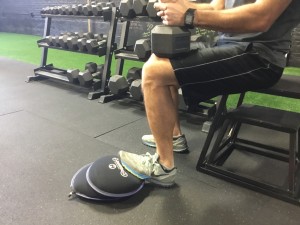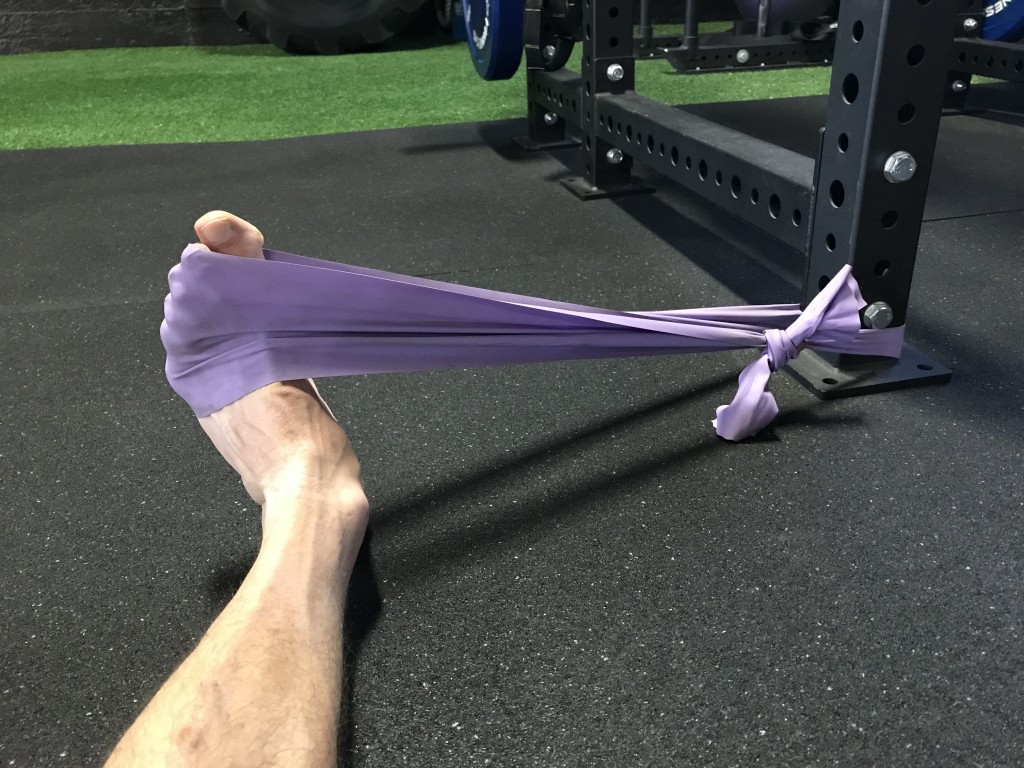I wrote recently about my experience with posterior tibialis tendinitis. This post continues the analysis of the problem and solutions that helped resolve the problem.
Posterior tibialis actions
The posterior tibialis (PT), and the gastrocnemius, soleus, and plantaris, (all muscles that attach to the Achilles tendon) overlap to some degree in how they function in gait. What do those muscles do you ask?
- Concentric function (when the muscle contracts and shortens): plantar flexion (points the foot), inversion (sole of the foot turns in)
- Eccentric function (when the muscle lengthens): decelerates dorsiflexion (bending of the ankle), decelerates eversion (sole of the foot turns out)
Gastrocnemius/soleus/plantaris actions at the ankle
- Concentric: plantar flexion
- Eccentric: decelerates dorsiflexion
- The gastroc and soleus attach to the heel via the Achilles tendon.
In the case of my Achilles pain, I found relief from strengthening those calf muscles through doing a lot of slow, controlled heel lifts. I thought the same approach would resolve my PTT. I was wrong. I believe that my efforts at strengthening the PT and the PT tendon aggravated the problem and caused more foot pain. I believe my PTT was rooted in a rigid left arch and rigid plantar fascia.
Plantar fascia flexibility, pronation, and force distribution
For years I’ve noticed that my left arch doesn’t pronate (collapse) as much as the right. I believe this lack of movement is part of my problem. In my prior post, I asked the question, “Do you have the mobility to get into the position required by your activity?” As it regards my left arch and running, my answer was, “No.”
Among many runners, the word “pronation” equates to “bad.” That’s wrong. (Uncontrolled or excessive pronation is bad.) Pronation is a necessary movement that contributes to deceleration of the foot, lower leg, and the rest of the body during foot strike. As the arch collapses, the plantar fascia acts as a leaf spring, storing then returning valuable energy that helps propel the runner forward. This energy return occurs as the foot supinates with the arch lifting as the runner pushes away from the ground.
The plantar fascia isn’t the only participant in this process of energy absorption and return. All the muscles and connective tissue throughout the body contributes to the process. The tendons of the lower leg, such as the Achilles tendon and the posterior tibialis tendons, are highly active during this process. If everything is moving correctly, in control, and in a coordinated fashion then the impact forces of running are distributed efficiently among all of the muscles and tendons.
Now imagine if some link in this kinetic chain isn’t moving the correct way. If that happens then other regions and other structures of the body will be forced to handle more than their fair share of the load. Some sort of overload, injury, and pain is likely in this scenario. Specific to my case, I believe the lack of mobility of my left plantar fascia has contributed directly to my past Achilles tendon problems, plantar fasciitis, and to my recent bout with PTT. Plantar Fasciitis and the Windlass Mechanism: A Biomechanical Link to Clinical Practice is a literature review from the Journal of Athletic Training. This review provides the following pertinent comments:
“Researchers have also reported faulty biomechanics and plantar fasciitis in subjects with a higher-arched foot.16–18 A higher-arched foot lacks the mobility needed to assist in absorbing ground reaction forces. Consequently, its inability to dissipate the forces from heel strike to midstance increases the load applied to the plantar fascia, much like a stretch on a bowstring.4
“A review of the literature reveals that a person displaying either a lower- or higher-arched foot can experience plantar fasciitis. Patients with lower arches have conditions resulting from too much motion, whereas patients with higher arches have conditions resulting from too little motion.4,16,19 Therefore, people with different foot types experience plantar fascia pain resulting from different biomechanical stresses.”
(The article is thorough and informative about foot mechanics. If you’re a runner suffering from foot problems, a running coach, or a clinician who treats these issues then I think it could be valuable to you.)
Exercises that helped
- I foam rolled the calf. You probably know how to do that. If not, look on Youtube.
- Band eversion/dorsiflexion: It’s one of the exercises discussed here. I did and continue to do the exercise with very high reps. It looks like this:
- Bent-knee heel raises: I used high reps but there is probably benefit to using heavier weight with fewer reps. There are machines for this exercise at many gyms. I don’t have access to such a machine so I did it by stacking up some sandbags under the front of my foot and putting a dumbbell on my knee. I worked to high exertion for several sets:


- Arch mobilizer: It takes time to make changes to tissues so I do this frequently throughout the day.
- Gait check: This is HUGE! In my first meeting with running coach Andrew Simmons of Lifelong Endurance, he noticed several problems with my gait. These were problems seen in the past with my gait.
(This illustrates the immense power of working with a coach. I don’t know what I don’t know and I can’t see what I can’t see—and neither can you! My technique had slipped and I didn’t know it.)- My ground contact time (or how long my foot was on the ground) was too long. Thus, my feet and lower legs spent a lot of time transmitting stress through my lower leg. That may have been a part of overloading the PT tendon. This long contact time was probably a result of…
- A low-energy gait. My legs weren’t rebounding off of the ground sufficiently and the whole gait cycle was sluggish. Now, as I run, I think of a strong, quick, powerful push into the ground. I drive the leg behind me, and I push the ground behind me.When I run correctly, my foot spends less time on the ground and the tissues spend less time under stress and I’m more efficient. Read How to Run: Running With Proper Biomechanics by Steve Magness for details on running technique including the need for hip extension.
Finally
Solving the riddle of the sore left foot has been a prolonged, tricky struggle. Every time I find relief I think I’ve solved the problem only to have some other problem pop up later. That said, I now think I’ve figured it out. I could be wrong. Maybe some of this information will help other runners overcome their foot and ankle troubles too.


